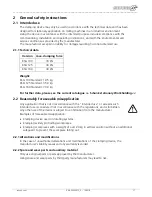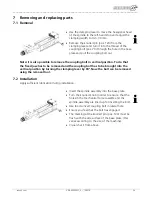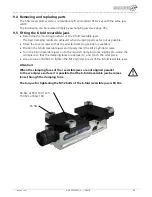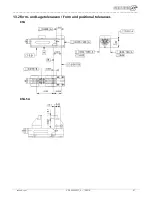
_________________________________________________________________________________________
schunk.com
XND.00005.022_A – 10/2018
39
9
Swivel and adapter plate
9.1
Function
Slanted and curved items can be securely clamped with 4-point clamping using the swivel
plate system.
The swivel plate is pulled downwards during the clamping process due to its conical swivel
plate bearings; this means that the swivel plate is not likely to lift off.
With the 6-fold reversible jaw it is possible to cover numerous clamping solutions in a
straightforward way. A total of six different clamping sides are available, at the four sides of
the reversible jaw as well as at two places with a convex "grip" profile.
It is also possible to carry out two-sided processing using the tungsten carbide coated side of
the 6-fold reversible jaw.
Processing the first side
For raw part clamping using the 6-fold reversible jaw, five different "grip" clamping sides are
available with a clamping depth of 3, 8 and 18 mm.
Processing the second side
Clamping with the tungsten carbide coated side of the 6-fold reversible jaw.
It is important to take into account that during the first clamping process, the 6-fold reversible
jaws can yield slightly until the play in the peg seating is eliminated.
The workpiece position must be measured; the zero point should not be determined until
after 3 to 5 power clampings.
Handling the demounted swivel plate
The conical swivel peg can be pulled out since it is only held in position by an O-ring
in the counter direction. When handling the swivel plate, it should not be turned upside
down since this could cause the peg to fall out.
9.2
Servicing, cleaning, maintenance
See page 37
Lubricating the swivel peg
The upper shoulder of the swivel peg must be oiled regularly. The swivel bearing is protected
by O-rings. In order to ensure that the areas under stress remain well lubricated, the swivel
plate should be turned around its entire axis once a week so that the lubrication film can be
renewed. Lubrication of the entire peg is recommended once a year.
9.3
Troubleshooting, eliminating faults
Swivel plate is difficult to turn
Disconnect the swivel plate and push the swivel peg from below out of the swivel plate.
Check the vice guide and swivel plate surface for indentations or deformations. If necessary,
re-grind the plate and the vice guide.
Check the peg for soiling.
Check that the O-rings are correctly positioned. The upper O-ring must make good contact.
Re-lubricate the entire system with grease and reassemble.










































